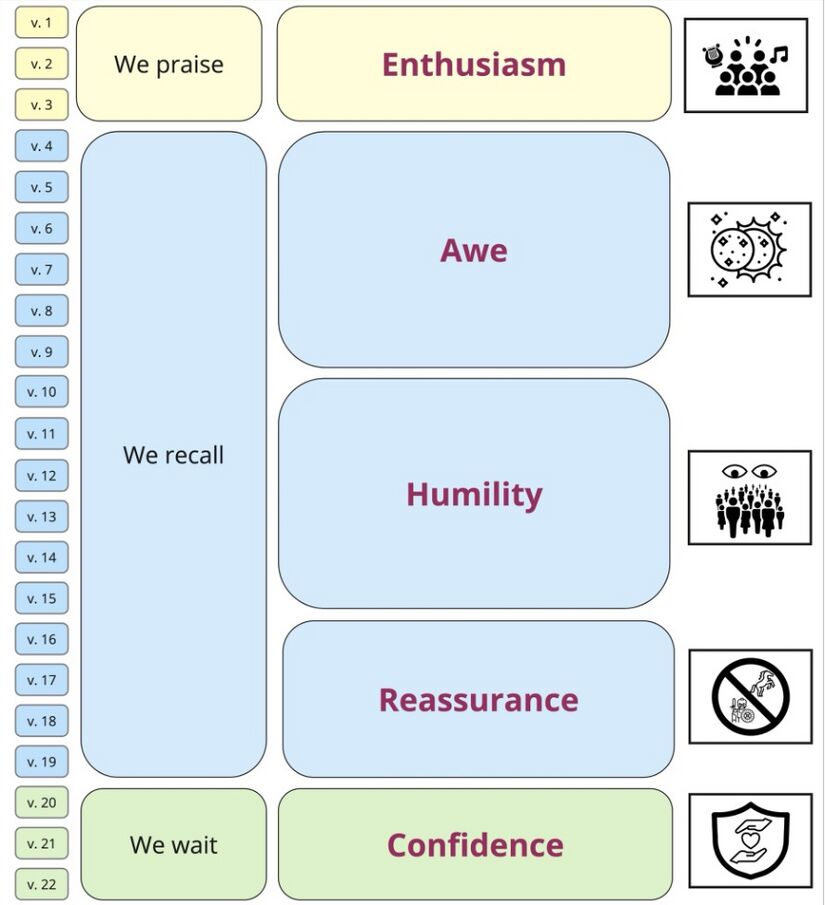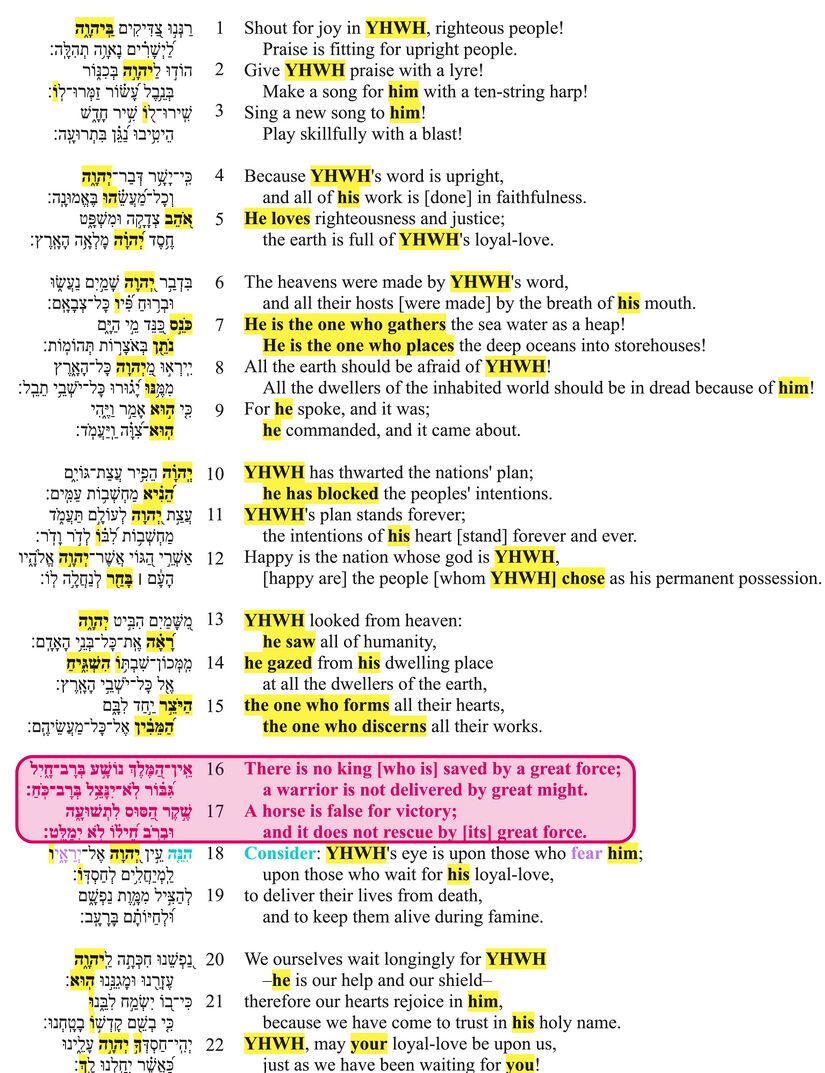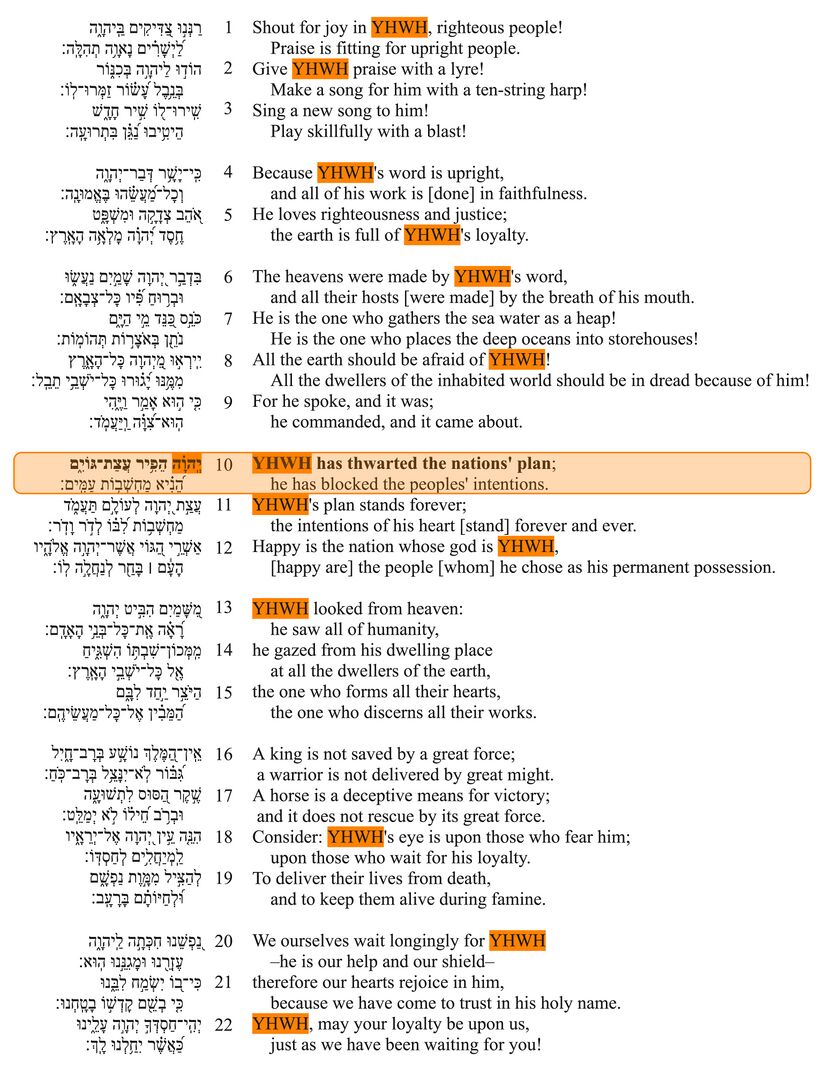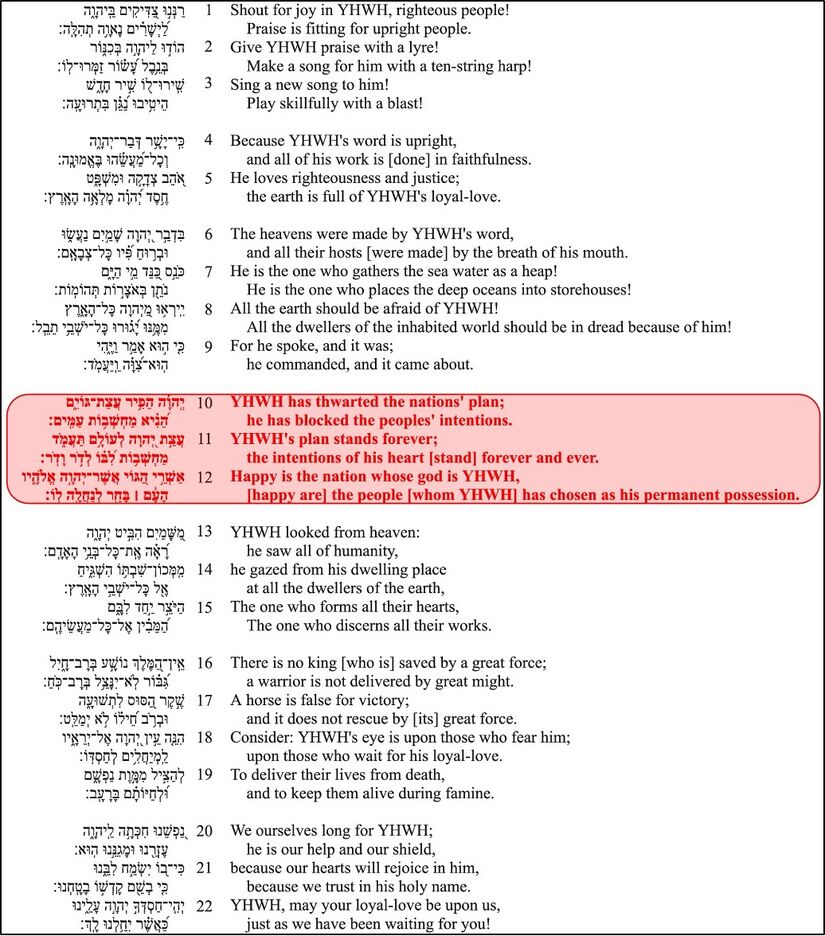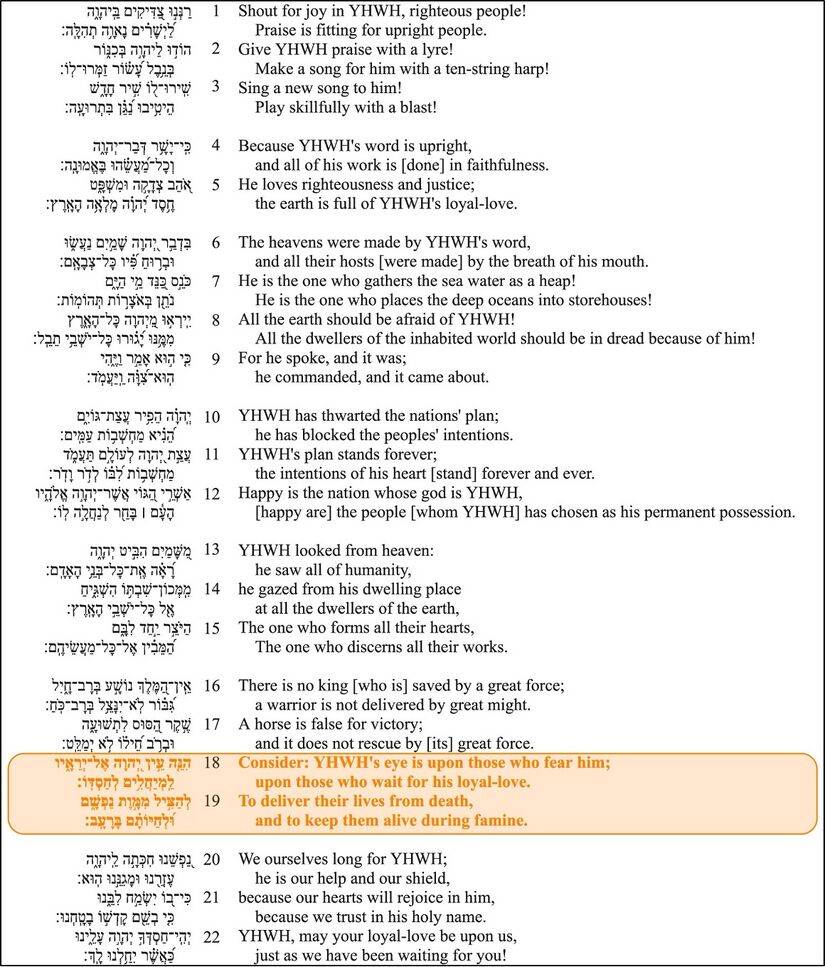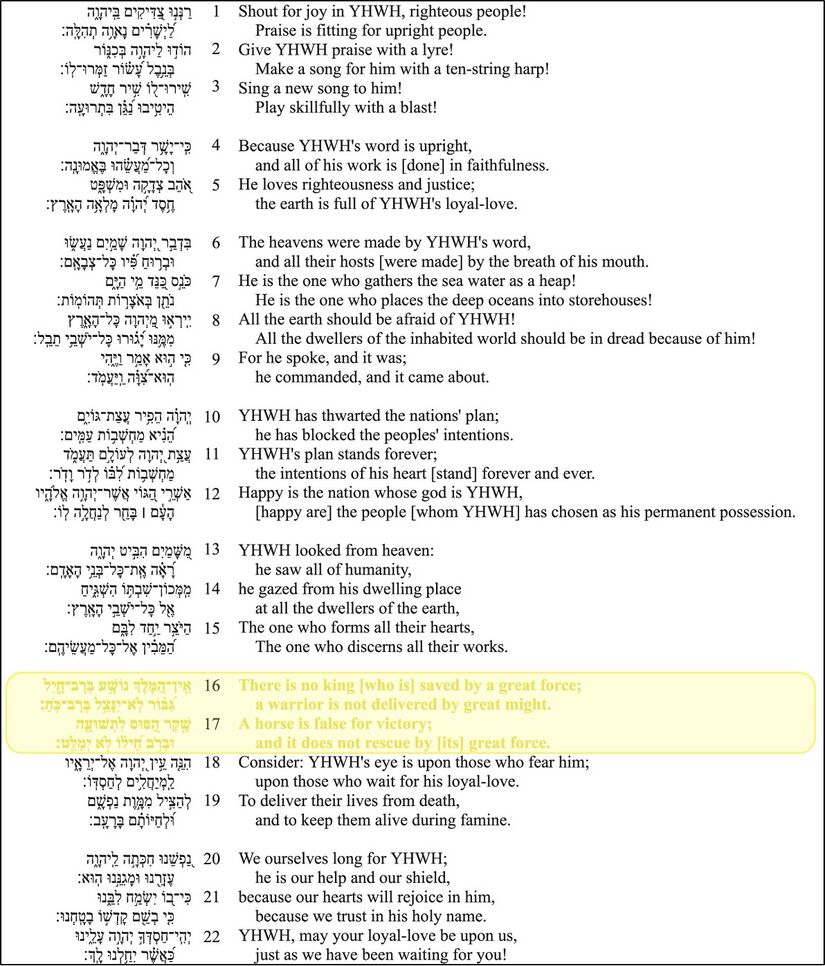Psalm 33/Translation/Tips
The following gives a gives a basic Overview of the Psalm, answering the following questions:
- Title-What title best describes this unique psalm?
- YHWH's Plan Stands Forever
- Purpose–Why was this psalm written?
- To inspire YHWH's people to worship while trusting in his loyal plan.
- Content–In summary, what is said in this psalm?
- We remember what YHWH has done in the past. That's why we praise YHWH, and that's why we wait for him to do the same again.
- Message–What is the general theme of this psalm? What seems to be the main point the psalmist wanted his audience to realize by hearing this psalm?
- Don't give up on God! Praise him as we wait on his plan!
Every psalm has a coherent story behind it. However, many psalms are not written in typical "story" format, with a clear beginning, middle, and end. Here, we attempt to understand the story and background that prompted the psalmist to write.
- Story Behind-How do the various parts of the psalm fit together into a single, coherent story? What is the main message/theme conveyed by this "story behind"?
- Difficulty arises for YHWH's people, and they long for him and wait for him. That's why YHWH's righteous people gather and worship him in song through the singing of this psalm. As they do so, they remember his acts in creation in history. These acts include his past deliverances, in which the nations threatened YHWH's people, but YHWH prevented the nations' plan.
- Sometime after the psalm is sung, YHWH judges humanity. He delivers his people from their enemies and sustains his people in the face of natural disaster. So, YHWH's people rejoice in him.
- Background Situation-what are the series of events leading up to the time in which the psalm was written?

Knowing the layout of the psalm by sections helps us to understand the progression of thought as the poem progresses.
How to read the visual below: The picture below shows the main “chunks” or pieces of the poem. Verse numbers appear on the left. The second column has a title for each section. The large third column contains a brief summary of the section’s content. As you read through the content column, you will see important words and ideas highlighted in similar colors. The icons on the right may be used as memory aids.
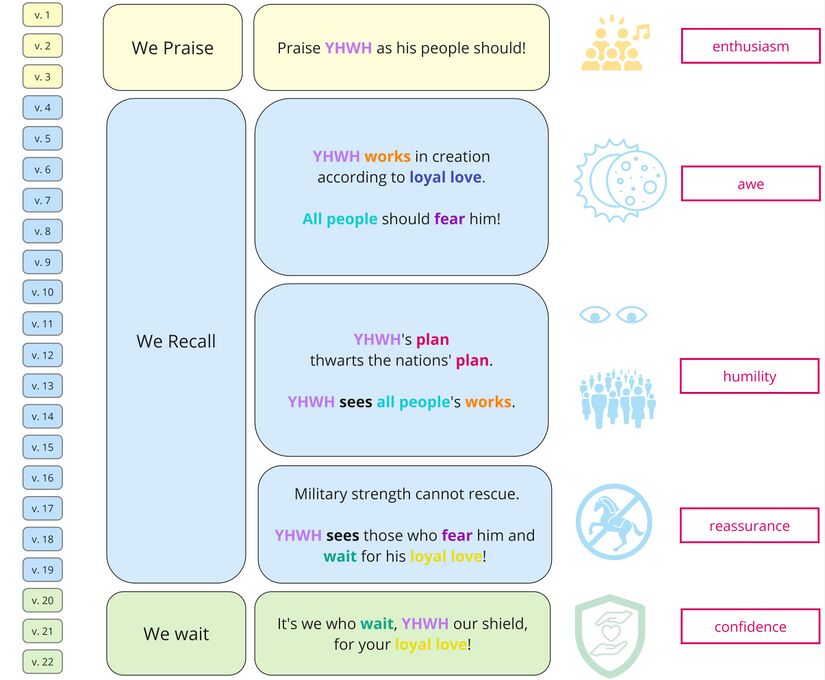
Progression of Thought-How do the sections of the psalm flow from one to the other?
- The progression of the psalm moves through three sections:
- The opening three verses call YHWH's people to make joyful praise.
- Then the long middle section explains why to praise. The middle section starts with a summary statement that YHWH's works are good and they fill the world. The middle section then gives three examples of YHWH's good works in the world. The examples are: 1) YHWH has powerfully ordered creation, 2) YHWH has stopped other nations, so his nation is happy, and 3) YHWH has seen all people, so he discerns their works. The middle section continues with a reminder that armies and horses cannot save, but YHWH watches to save those who fear and wait for him.
- In the final three verses, the people declare that they are the ones who wait for and trust in YHWH. So, they ask YHWH to apply his loyal love to them.
Part of poetry is communicating emotion. Each section, and even each verse, can contain a number of different emotions. Here are the main emotional themes of each section:
In poetry, it is important to keep track of who is speaking, who is the audience, and what it is that the speaker is trying to do with his words.
In the chart below, the left-hand column identifies the speaker. For the first 19 verses of this psalm, the speaker is the choir director, and in verses 20-22 the choir director and the people join together to speak.
The right-hand column identifies the audience, which is Israel - except for the last verse of the psalm, where the audience is YHWH.
The middle column tells what the speaker is trying to do with his words (his speech acts) in each section. An exhortation like the one in verses 1-3 actively urges someone to do something: in this case, praise! A petition like the one in verses 20-22 is a request: in this case, the people request that YHWH will apply his loyal love to them.
In this section, we ask, "what kinds of artistic beauty did the psalmist incorporate into the poem to reinforce its message?" (See Poetic Features video and layer for more details.)
Feature 1: Absence of YHWH
YHWH appears as a participant in every verse of this psalm except verses 16-17.[1] YHWH's absence in these verses makes them stand out within the psalm. After exclusively positive verses about YHWH for the whole psalm, there is an emotional shift in verses 16-17. There is nothing positive in verses 16-17, which only discuss false hopes for victory (kings, warriors, and horses).
The absence of YHWH creates a kind of poetic pause here. Then, immediately following verses 16-17, the psalmist calls the audience to attention with the discourse particle "Consider" (הִנֵּה) in verse 18a. This call to consider that YHWH is paying attention may suggest that people were tempted to do the opposite: to trust in military strength, to doubt YHWH’s attentiveness, and to seek alternative means of rescue. Without directly accusing anybody of such a thought, the poetry of verses 16-19 argues both against all human means for victory and for strict dependence on YHWH alone.
Feature 2: The Unexpected Enemies
YHWH’s name occurs 6 times in verses 1-9 and 6 times in verses 11-22. Six occurrences, in Hebrew poetry, is distinctively “imperfect,” meaning that both sections need the occurrence of YHWH in verse 10a in order to achieve a perfect seven occurrences of the divine name. Thus, verse 10a structurally binds the psalm together in the middle.
Strikingly, verse 10a presents a state of affairs to the psalm that is unexpected and new. There are no overt clues in the first 9 verses of the psalm that the nations are a concern, that they have a plan, or that YHWH has thwarted their plan. As so many times in the Psalms, enemies did not need to be explicitly mentioned in order to be present. But YHWH's people did not need to fear these enemies, because YHWH would always thwart them. The discussion of YHWH’s power over creation (verses 4-9) establishes his equal power over enemies and their plans (verses 10-15).
Additionally, the name YHWH is fronted at the very beginning of verse 10a, and this is the only time this happens within the psalm, despite YHWH's name appearing 13 times. The result is a stress upon YHWH: "(It was YHWH who) thwarted the nations' plan." This is not simply a hymn in praise of YHWH. It reassures those singing that YHWH always has (and always will) thwart enemy plans. That is what gives them cause to rejoice even while they long and wait for him.
Feature 3: YHWH's nation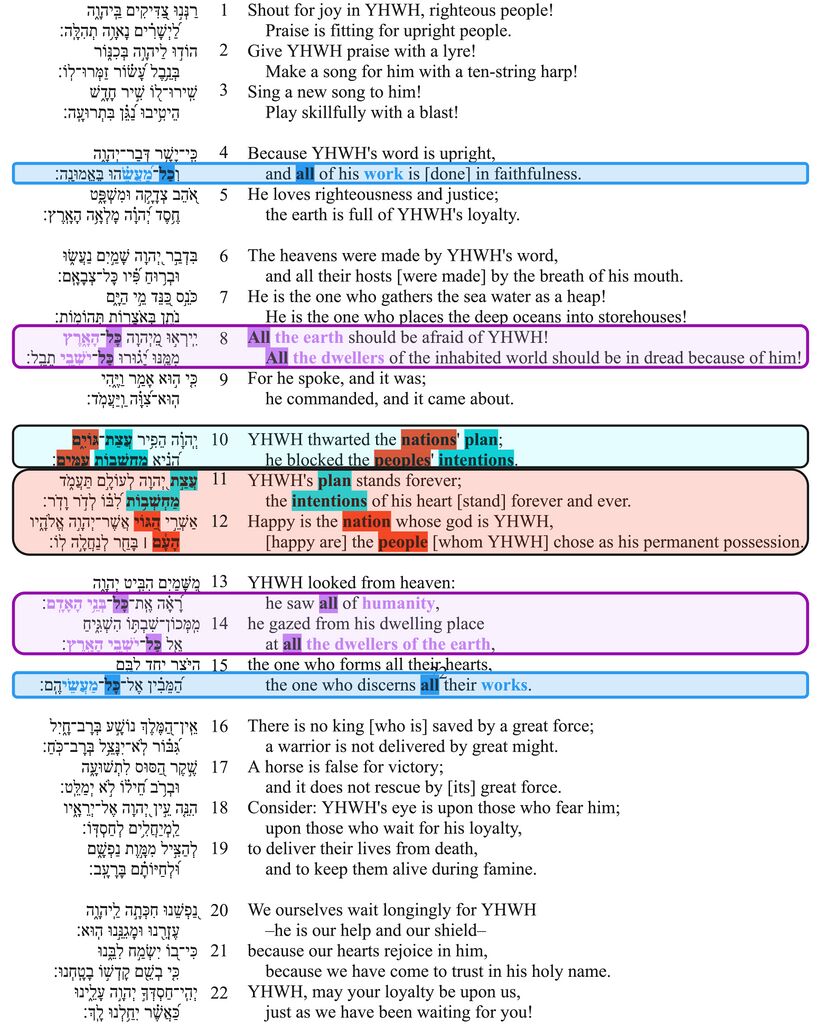
At the center point of Psalm 33, the psalmist uses word play to contrast the nations of the earth and the LORD and his nation. Verse 10 speaks of the nations' plan and intentions, which are contrasted with YHWH's plan and intentions in the next verse (verse 11). Verse 10 also refers specifically to the the nations (גוים) and peoples (עמים), which are contrasted with Israel, YHWH's nation (הגוי) and people (העם) in verse 12.
The word play in these central verses present a reversal, where the nations' plan and intentions do not last, but are thwarted. The central location of this feature within the psalm reflects the central message of the psalm to trust in YHWH's plan instead of military strength.
It is also important to consider how the author chose to draw attention to certain parts of the psalm. Here are the parts of the psalm that we believe are most prominent, and thus should be most prominent in a performance of the psalm.
The most prominent part of Psalm 33 is verses 10-12:
- These verses contrast the plan and intentions of the nations with the plan and intentions of YHWH.
- The nations plan to destroy the people of God, but YHWH thwarts the plan of the nations.
- YHWH's plan is to rescue his people, and his plan stands forever.
- Therefore, YHWH's people are happy.
The second-most prominent part of the psalm is verses 18-19:
- Verses 18-19 tie together many important themes from earlier in the psalm: YHWH's loyal-love (from verse 5), fearing YHWH (from verse 8), and YHWH's looking (from verses 13-15).
- Verses 18-19 turn these themes into a promise that the audience applies to themselves in the final section (verses 20-23). YHWH looks at those who fear him, so that YHWH will apply his loyal love to them.
The third-most prominent part of the psalm is verses 16-17.
- Every verse in the psalm features YHWH as a participant, except verses 16-17.
- Instead of YHWH, the main participants of these verses are agents of war such as a king, a warrior, and a horse.
- The emotional effect of these verses is to create a void, or an emotional let-down, after verses 4-15 have given many positive examples of YHWH's character and activity. This sets up the audience to "Consider" the promise of verses 18-19.
- ↑ Verse 19 also does not mention YHWH, but it is not a complete sentence since it only contains infinitive verbs, and is therefore dependent upon v. 18, which mentions YHWH.
